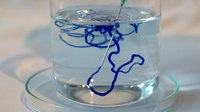
Photo from wikipedia
Purpose This study/paper aims to develop fundamental understanding of mechanical properties for multiple fibre-reinforced materials by using a single-filament-wide tensile-testing approach. Design/methodology/approach In this study, recently validated single-filament-wide tensile-testing specimens… Click to show full abstract
Purpose This study/paper aims to develop fundamental understanding of mechanical properties for multiple fibre-reinforced materials by using a single-filament-wide tensile-testing approach. Design/methodology/approach In this study, recently validated single-filament-wide tensile-testing specimens were used for four polymers with and without short-fibre reinforcement. Critically, this specimen construct facilitates filament orientation control, for representative longitudinal and transverse composite directions, and enables measurement of interlayer bonded area, which is impossible with “slicing” software but essential in effective property measurement. Tensile properties were studied along the direction of extruded filaments (F) and normal to the interlayer bond (Z) both experimentally and theoretically via the Kelly–Tyson model, bridging model and Halpin–Tsai model. Findings Even though the four matrix-material properties varied hugely (1,440% difference in ductility), consistent material-independent trends were identified when adding fibres: ductility reduced in both F- and Z-directions; stiffness and strength increased in F but decreased or remained similar in Z; Z:F strength anisotropy and stiffness anisotropy ratios increased. Z:F strain-at-break anisotropy ratio decreased; stiffness and strain-at-break anisotropy were most affected by changes to F properties, whereas strength anisotropy was most affected by changes to Z properties. Originality/value To the best of the authors’ knowledge, this is the first study to assess interlayer bond strength of composite materials based on measured interlayer bond areas, and consistent fibre-induced properties and anisotropy were found. The results demonstrate the critical influence of mesostructure and microstructure for three-dimensional printed composites. The authors encourage future studies to use specimens with a similar level of control to eliminate structural defects (inter-filament voids and non-uniform filament orientation).
Journal Title: Rapid Prototyping Journal
Year Published: 2023
Link to full text (if available)
Share on Social Media: Sign Up to like & get
recommendations!